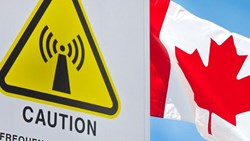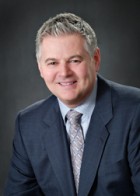Canada Considers Input on Wi Fi Safety, Wireless Health Concerns
Submitted by Lee Rickwood on July 21, 2014 – 3:33 pm
The open window for public input on wireless radiation and RF safety in Canada has closed, but the debate about possible negative health impacts from using wireless devices rages on.
Health Canada closed its consultation and comment period last week. Having noted a significant stakeholder interest in RF safety, the government agency encouraged interested parties to provide commentary and make suggestions about Wi-Fi safety, wireless device usage and related health concerns.

Canada’s safety code for wireless devices and wi fi emissions is being reviewed for possible updates and revisions, and it will be released this fall.
Health Canada says it will finalize and publish a revised Safety Code 6, its set of guidelines and suggestions for the safe use of electromagnetic devices, this fall.
That’s the good news.
But others say bad news is also contained in the government’s announcement: the call for input clearly stated that only feedback of a scientific nature will be considered as Health Canada looks at Safety Code 6.
Important information and input could be missed in that case, such as that offered by Toronto’s City Council, which has encouraged Health Canada to “revise Safety Code 6 so that it meets international best practices, in consultation with the public and appropriate experts”.
It could also mean that information provided by wireless device manufacturers is ignored – many user manuals and product spec sheet do contain recommendations for device use with suggested minimum distances between the body and the device.
Or the information presented by health and safety organizations with a mandate to properly train workers should they encounter RF as part of their job duties. That surely includes those who work on and around communications towers and transmission facilities, but RF can be encountered by many other workers, including roofers, HVAC professionals, window washers, heavy equipment operators, landscapers, plumbers, and manufacturing personnel.
Perhaps input from careful manufacturers, city councillors, worker/trainers or even regional school boardsis not the kind of scientific input the government agency is looking for, yet regulators are still wary of changes to the regulations or to devices themselves, no matter the motivation – industry representatives have said that, in order to bring Code 6 up to some higher standard, consumer costs related to cellphone usage and mobile device purchases could go up.
In any event, Health Canada did receive input from over twenty specialists, as tabled in a press conference they held prior to the consultation’s closing date.
The event was coordinated by Citizens for Safe Technology, C4ST, a not for profit advocacy group pushing for greater awareness of wireless related health hazards, and more stringent government rules and regulations regarding wireless use and deployment.
Frank Clegg, a former head of Microsoft Canada, leads the group, which he says has made submissions to Health Canada as well as tabling information at the public event.
(Clegg’s term at Microsoft was more than ten years ago, at a time when wireless devices were not as ubiquitous as today. Nevertheless, some find it ironic at best that a former tech leader is now taking an ‘anti-tech’ position.
Clegg is sensitive to the charge: “I do regret, quite truthfully, the ‘push’ we made back then to get the technology into schools. I know more now than I did then,” he acknowledges.)
He’s learned from many physicians, researchers and scientists over the years, and more than a dozen of the doctors who joined him at the press confernce are speialists in the field of environmental medicine, including a past President of the American Academy of Environmental Medicine, and the group includes professors of medicine from the Universities of Toronto, British Columbia, Ottawa and McMaster.
The doctors do cite scientific evidence they say now points to the probability that low level microwave radiation from cell phones, Wi-Fi and cell towers can cause a range of health problems, including infertility and cancer.
The doctors are encouraged by reports of on-going international studies, and supported by international experts in biology and microwave radiation who agree that Health Canada must update its safety guidelines in order to better protect Canadians, and especially children.
“Health Canada’s Safety Code 6 is based on an obsolete account and analysis of Radiofrequency Radiation research,” said Dr. David Carpenter MD, PhD, Director, Department of Public Health, State University of New York, Albany. It has “disregarded or minimized certain recent studies” he added, about “detrimental biological and health effects in humans that occur at radiation levels far below the existing Safety Code 6 Guideline”.
But the assembled Health Canada panel that looked at the code concluded its published limits “are science-based and … designed to avoid all known hazards of radiofrequency radiation,” said panel chair Paul Demers, director of the Occupational Cancer Research Centre in Toronto.
However, the panel has noted (even as controversy swirls around its mandate and membership) that Health Canada should look more closely at research into whether radiofrequency waves from wireless devices such as smartphones are linked to cancer.
“That certainly is one of the areas that has arisen as a concern,” Demers said.
Safety Code 6, also referred to as Limits of Human Exposure to Radiofrequency Electromagnetic Energy in the Frequency Range from 3 kHz to 300 GHz, contains Health Canada guidelines and limits for safe human exposure to radiofrequency (RF) electromagnetic fields (EMF).
Health Canada has said its 2014 proposed revisions will make Canada a global leader in putting in place conservative science-based limits.
Of course, true science is not a popularity contest, according to noted physician, researcher, author and academic W.Ross Adey. MD. Back in 1979 – 1979! – he authored a paper entitled ‘Neurophysiologic Effects of Radiofrequency and Microwave Radiation’.
His work certainly showed some impacts from low frequency radiation on brain function, biological states and cognitive behaviours, although interestingly enough, it seems he could see both negative consequences and potential therapeutic value.
Either way, with no cellphones to use, he neverthless could hear the future calling, and he warned of its arrival: “Future research may indicate that long-term human exposure to these particular low-frequency characteristics should be avoided or carefully controlled.”
Clegg says his group is not waiting for that future, or for the new Code 6.
He has asked the Minister responsible for a direct meeting with his group well in advance of the expected fall release, and he hopes to receive a reply within a few weeks.
-30-
Submitted by Lee Rickwood


No comments:
Post a Comment